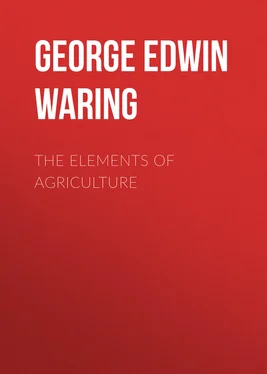George Edwin Waring - The Elements of Agriculture
Здесь есть возможность читать онлайн «George Edwin Waring - The Elements of Agriculture» — ознакомительный отрывок электронной книги совершенно бесплатно, а после прочтения отрывка купить полную версию. В некоторых случаях можно слушать аудио, скачать через торрент в формате fb2 и присутствует краткое содержание. Жанр: foreign_prose, Биология, foreign_edu, foreign_antique, на английском языке. Описание произведения, (предисловие) а так же отзывы посетителей доступны на портале библиотеки ЛибКат.
- Название:The Elements of Agriculture
- Автор:
- Жанр:
- Год:неизвестен
- ISBN:нет данных
- Рейтинг книги:3 / 5. Голосов: 1
-
Избранное:Добавить в избранное
- Отзывы:
-
Ваша оценка:
- 60
- 1
- 2
- 3
- 4
- 5
The Elements of Agriculture: краткое содержание, описание и аннотация
Предлагаем к чтению аннотацию, описание, краткое содержание или предисловие (зависит от того, что написал сам автор книги «The Elements of Agriculture»). Если вы не нашли необходимую информацию о книге — напишите в комментариях, мы постараемся отыскать её.
The Elements of Agriculture — читать онлайн ознакомительный отрывок
Ниже представлен текст книги, разбитый по страницам. Система сохранения места последней прочитанной страницы, позволяет с удобством читать онлайн бесплатно книгу «The Elements of Agriculture», без необходимости каждый раз заново искать на чём Вы остановились. Поставьте закладку, и сможете в любой момент перейти на страницу, на которой закончили чтение.
Интервал:
Закладка:
Although ammonia is a gas and pervades the atmosphere, few, if any, plants can take it up, as they do carbonic acid, through their leaves. It must all enter through the roots in solution in the water which goes to form the sap. Although the amount received from the atmosphere is of great importance, there are few cases where artificial applications are not beneficial. The value of farm-yard and other animal manures, depends chiefly on the ammonia which they yield on decomposition. This subject, also the means for retaining in the soil the ammoniacal parts of fertilizing matters, will be fully considered in the section on manures.
Can plants use more ammonia than is received from the atmosphere?
On what does the value of animal manure chiefly depend?
What changes take place after ammonia enters the plant?
May the same atom of nitrogen perform many different offices?
After ammonia has entered the plant it may be decomposed, its hydrogen sent off, and its nitrogen retained to answer the purposes of growth. The changes which nitrogen undergoes, from plants to animals, or, by decomposition, to the form of ammonia in the atmosphere, are as varied as those of carbon and the constituents of water. The same little atom of nitrogen may one year form a part of a plant, and the next become a constituent of an animal, or, with the decomposed dead animal, may form a part of the soil. If the animal should fall into the sea he may become food for fishes, and our atom of nitrogen may form a part of a fish. That fish may be eaten by a larger one, or at death may become food for the whale, through the marine insect, on which it feeds. After the abstraction of the oil from the whale, the nitrogen may, by the putrefaction of his remains, be united to hydrogen, form ammonia, and escape into the atmosphere. From here it may be brought to the soil by rains, and enter into the composition of a plant, from which, could its parts speak as it lies on our table, it could tell us a wonderful tale of travels, and assure us that, after wandering about in all sorts of places, it had returned to us the same little atom of nitrogen which we had owned twenty years before, and which for thousands of years had been continually going through its changes.
Is the same true of the other constituents of plants?
Is any atom of matter ever lost?
The same is true of any of the organic or inorganic constituents of plants. They are performing their natural offices, or are lying in the earth, or floating in the atmosphere, ready to be lent to any of their legitimate uses, sure again to be returned to their starting point.
Thus no atom of matter is ever lost. It may change its place, but it remains for ever as a part of the capital of nature.
CHAPTER IV
What are ashes called?
How many kinds of matter are there in the ashes of plants?
Into what three classes may they be divided?
What takes place when alkalies and acids are brought together?
We will now examine the ashes left after burning vegetable substances. This we have called inorganic matter, and it is obtained from the soil. Organic matter, although forming so large a part of the plant, we have seen to consist of four different substances. The inorganic portion, on the contrary, although forming so small a part, consists of no less than nine or ten different kinds of matter. 2 2 Bromine, iodine, etc., are sometimes detected in particular plants, but need not occupy the attention of the farmer.
These we will consider in order. In their relations to agriculture they may be divided into three classes— alkalies , acids , and neutrals . 3 3 This classification is not strictly scientific, but it is one which the learner will find it well to adopt. These bodies are called neutrals because they have no decided alkaline or acid character.
Is the character of a compound the same as that of its constituents?
Give an instance of this.
Do neutrals combine with other substances?
Name the four alkalies found in the ashes of plants.
Alkalies and acids are of opposite properties, and when brought together they unite and neutralize each other, forming compounds which are neither alkaline nor acid in their character. Thus, carbonic acid (a gas,) unites with lime—a burning, caustic substance—and forms marble, which is a hard tasteless stone. Alkalies and acids are characterized by their desire to unite with each other, and the compounds thus formed have many and various properties, so that the characters of the constituents give no indication of the character of the compound. For instance, lime causes the gases of animal manure to escape, while sulphate of lime (a compound of sulphuric acid and lime) produces an opposite effect, and prevents their escape.
The substances coming under the signification of neutrals, are less affected by the laws of combination, still they often combine feebly with other substances, and some of the resultant compounds are of great importance to agriculture.
The alkalies which are found in the ashes of plants are four in number; they are potash , soda , lime and magnesia .
How may we obtain potash from ashes?
What are some of its agricultural uses?
When we pour water over wood ashes it dissolves the potash which they contain, and carries it through in solution. This solution is called ley , and if it be boiled to dryness it leaves a solid substance from which pure potash may be made. Potash left exposed to the air absorbs carbonic acid and becomes carbonate of potash, or pearlash ; if another atom of carbonic acid be added, it becomes super-carbonate of potash, or salæratus . Potash has many uses in agriculture.
1. It forms a constituent of nearly all plants.
2. It unites with silica (a neutral), and forms a compound which water can dissolve and carry into the roots of plants; thus supplying them with an ingredient which gives them much of their strength. 4 4 In some soils the fluorides undoubtedly supply plants with soluble silicates, as fluoric acid has the power of dissolving silica. Thus, in Derbyshire (England), where the soil is supplied with fluoric acid, grain is said never to lodge.
3. It is a strong agent in the decomposition of vegetable matter, and is thus of much importance in preparing manures.
4. It roughens the smooth round particles of sandy soils, and prevents their compacting, as they are often liable to do.
5. It is also of use in killing certain kinds of insects, and, when artificially applied, in smoothing the bark of fruit trees.
The source from which this and the other inorganic matters required are to be obtained, will be fully considered in the section on manures.
Where is soda found most largely?
What is Glauber's salts?
What is washing soda?
What are some of the uses of lime?
Soda , one of the alkalies contained in the ashes of plants, is very much the same as potash in its agricultural character. Its uses are the same as those of potash—before enumerated. Soda exists very largely in nature, as it forms an important part of common salt, whether in the ocean or in those inland deposits known as rock salt. When combined with sulphuric acid it forms sulphate of soda or Glauber's salts . In combination with carbonic acid, as carbonate of soda, it forms the common washing soda of the shops. It is often necessary to render soils fertile.
Lime is in many ways important in agriculture:
Читать дальшеИнтервал:
Закладка:
Похожие книги на «The Elements of Agriculture»
Представляем Вашему вниманию похожие книги на «The Elements of Agriculture» списком для выбора. Мы отобрали схожую по названию и смыслу литературу в надежде предоставить читателям больше вариантов отыскать новые, интересные, ещё непрочитанные произведения.
Обсуждение, отзывы о книге «The Elements of Agriculture» и просто собственные мнения читателей. Оставьте ваши комментарии, напишите, что Вы думаете о произведении, его смысле или главных героях. Укажите что конкретно понравилось, а что нет, и почему Вы так считаете.












